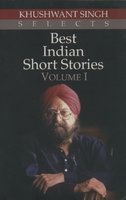As its name implies, “Khushwant Singh Selects Best Indian Short Stories (Volume 1)” is the first part of a collection of short stories written by various Indian authors and selected by Khushwant Singh, an eminent writer and a former editor of The Illustrated Weekly of India. These stories were originally published in English, Hindi, Urdu and other regional Indian languages and have been translated into English where necessary for inclusion in this book. Most of the stories collected here are fairly short and are fairly good, making this book an ideal read for short and long breaks alike.
In the introduction to the book, the editor notes:
[The Indian short story] sticks to the traditional rules of the craft. It is in fact short and not a novella or an abridged novel. It revolves round one or at the most two or three characters and does not have a long list of dramatis personae as in novels. It is limited in time and space and does not span decades or spread out in different locales. [...] It has a distinct beginning, a build-up and usually a dramatic end, frequently an unexpected one which sums up the story. Western short stories tend to be prolix, leaving the reader to guess what it is all about.
I think this perfectly describes almost all the stories included in this collection. Notable exceptions are the “stories” by Kabir Bedi and Hugh Gantzer, which seem more like journal-entries or essays than stories.
Some of the best-known Indian authors of short stories are represented here, including Mulk Raj Anand, Krishan Chander, Ruskin Bond, Ismat Chugtai, Kamala Das, Anita Desai, Shashi Deshpande, Qurratulain Hyder, Amrita Pritam, etc. While most authors are represented by a single story, except for Ruskin Bond and Krishan Chander with two stories each, Qurratulain Hyder has four stories in this collection. Was it because she was a colleague of the editor? Maybe, maybe not; what really matters is that all her selected stories are very nice.
Not all the major Indian languages are represented here and Urdu and Punjabi can well be considered over-represented, but that's a minor quibble. Perhaps that's just a reflection of the editor's tastes or reading-habits. Striving for such an artifical “fairness and balance” can easily become detrimental to the quality of such a collection.
It is not very clear from the introduction whether all the stories were first published in The Illustrated Weekly of India. If not, it is a little puzzling that some prominent Indian writers of very good short stories, like Munshi Premchand for example, were omitted from this collection. While the “best” in the title of the book is easily understood to be entirely subjective, it would have helped if the editor had listed some of the criteria used to select the stories in this book.
Be that as it may, the book is quite enjoyable and the quality of the stories good. I eagerly look forward to reading the second volume of this collection.
